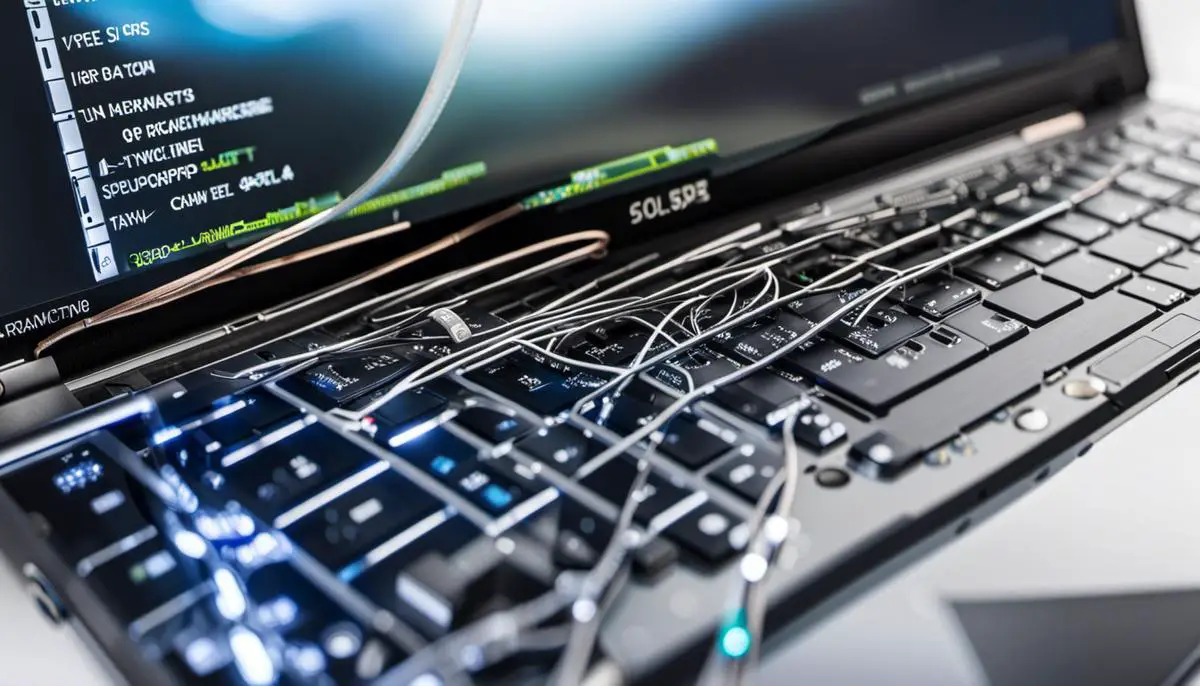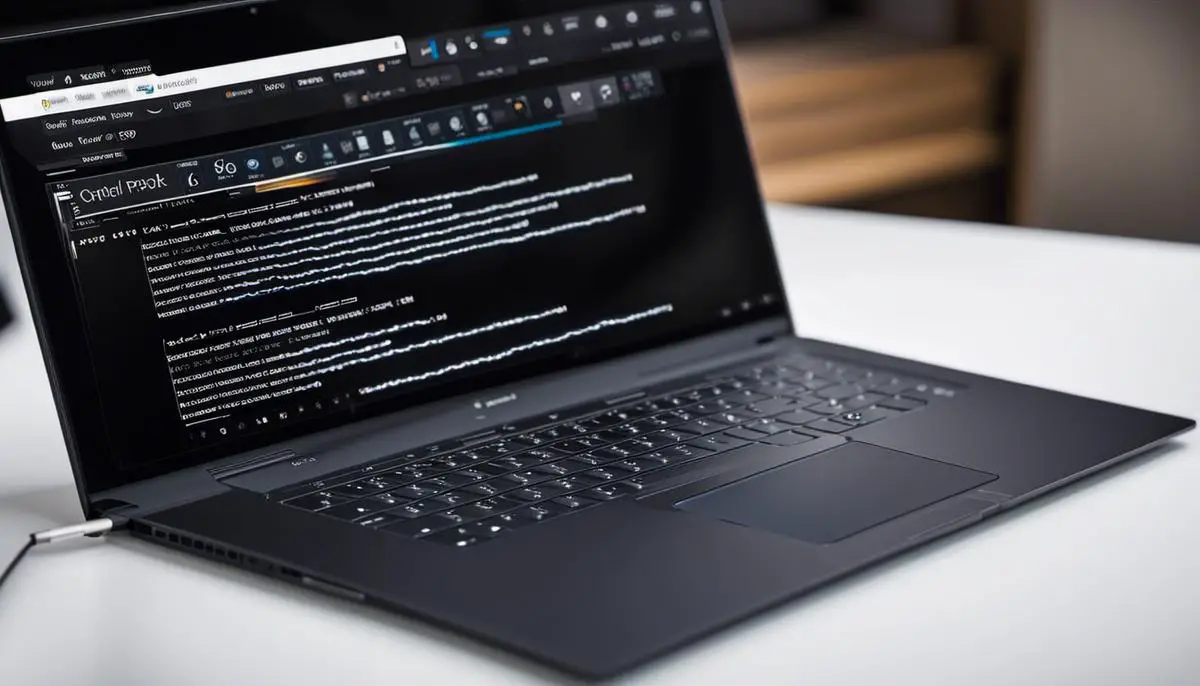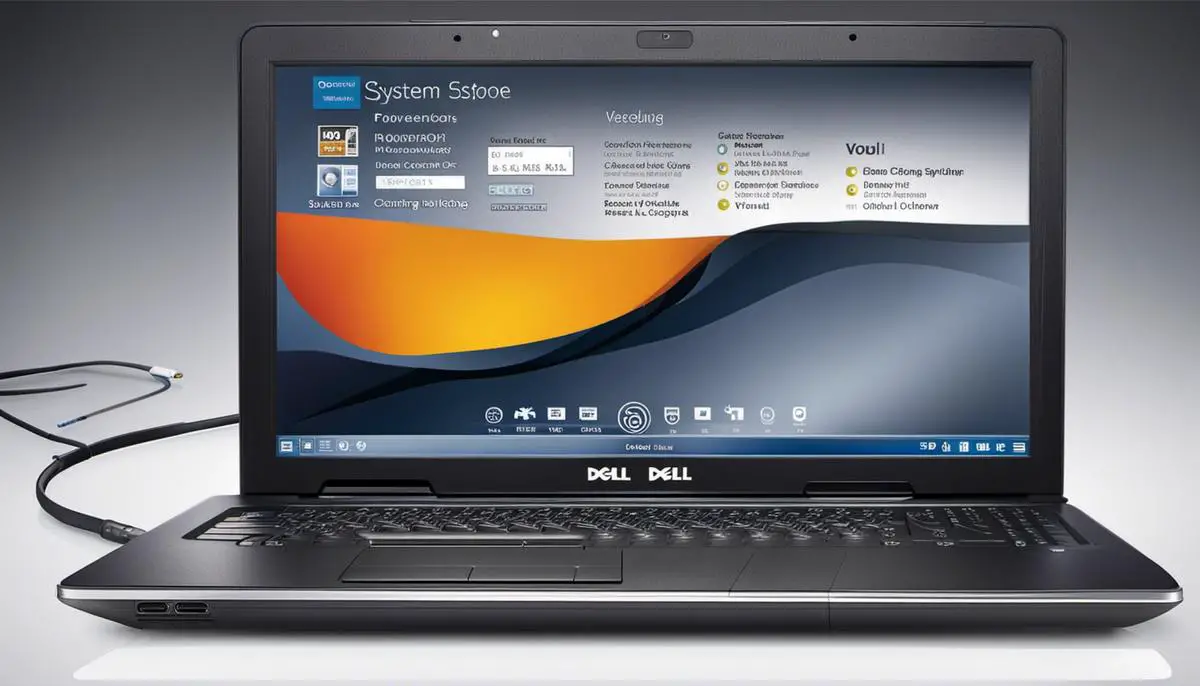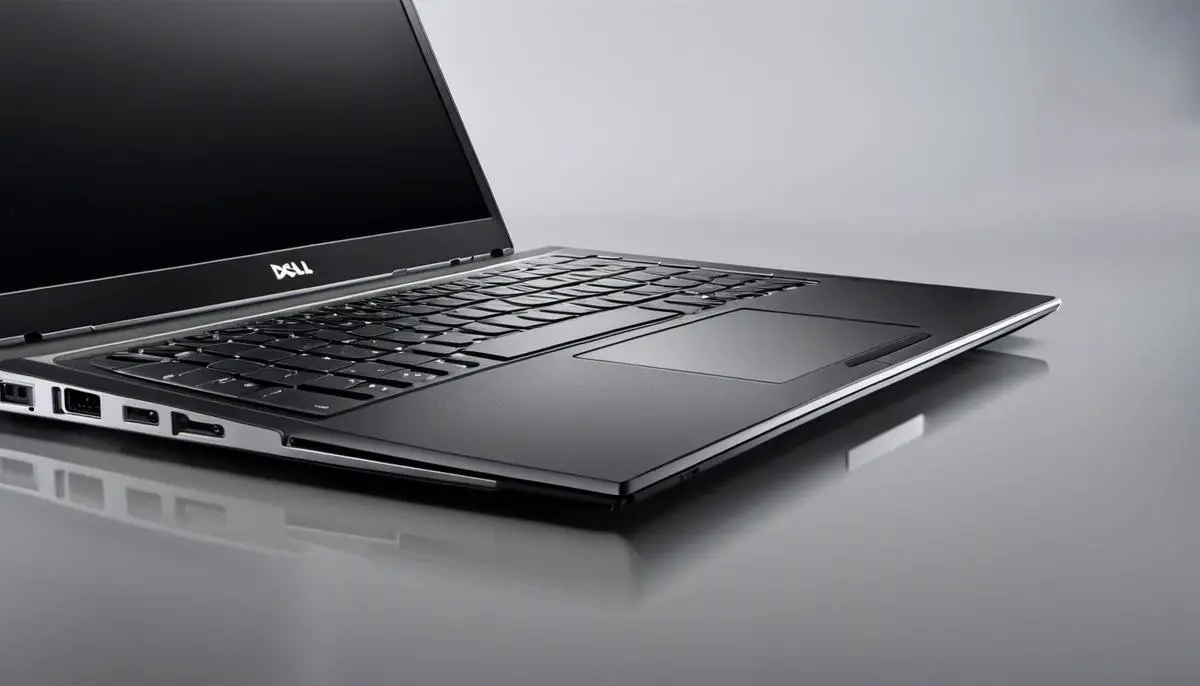Dell laptops, while known for reliability and performance, can still encounter issues.
A common problem is the black screen on startup.
This article provides a detailed guide on troubleshooting this issue, covering potential hardware problems, BIOS settings, operating system repairs, and RAM’s role in laptop performance. Understanding these aspects will help Dell laptop users maintain optimal device performance.
- Identify Potential Hardware Issues
- Step 1: Power Cycle the Laptop
- Step 2: Check for Loose Connections
- Step 3: Utilize Keyboard Shortcuts to Display Settings
- Step 4: Boot into Safe Mode and Update Drivers
- Step 5: Run Hardware Diagnostics Tests
- Step 6: Perform a System Restore or Reinstall Operating System
- Advanced Hardware Troubleshooting Steps for Dell Laptop Blank Display Issue
- Restore BIOS to Default Settings
- Repairing Operating System
- Checking the RAM
- Summary
Identify Potential Hardware Issues
Identify Hardware Issues
Begin by considering if the black screen could be attributed to any hardware issues.
- A common cause of a black screen can be the result of failure in a laptop’s backlight or video card.
Such failures are often due to overheating, power failures, or physical damage.
Any of these can bring about general functioning issues, intermittent malfunctioning, or complete failure. Remember, these are only possible causes and a professional diagnosis may be needed to confirm.
Assessing the Backlight and Video Card
To test for a failing backlight, try connecting your laptop to an external monitor.
If the screen display shows up properly on the external monitor, it may be a problem with your backlight.
However, if even on connecting to an external monitor, the screen remains black, it might be indicative of a video card failure.
Checking the Screen
To check if the laptop screen is broken, look out for cracks or physical signs of damage.
When the laptop is turned off, hold it up against a light source and look for shadows or signs of physical damage – these could be indicative of a broken screen.
Remember, even the smallest of cracks can cause significant damage.
Verify Power Supply
Checking the power supply is crucial for eliminating potential power issues.
Ensure the laptop’s power adapter is correctly plugged in both at the wall outlet and the laptop’s charging port.
- Look for indications that your laptop is receiving power, such as power LED lights coming on, fans running, or the laptop’s charging indicator lighting up.
If your laptop does not show these signs, try a different power adapter where possible, as issues might be due to a faulty power supply.
Related: Fixing Your Dell Laptop Keyboard: Troubleshooting Tips
Observing Hardware Issues Symptoms
Symptoms of laptop hardware issues are not always as direct as a black screen.
Other signs could include frequent system crashes, poor performance, and unresponsiveness. Keep an eye out for these signs as they may point to other hardware issues, aiding in the diagnostic process.
In conclusion, while these checks can help you identify potential causes of a black screen on your laptop, some more complex issues might need professional diagnosis and repairs.
If these steps do not help you resolve the problem, it may be time to consider professional help.

Step 1: Power Cycle the Laptop
Power cycling a laptop is often an effective first step in troubleshooting common issues, such as a black screen on startup.
This process refreshes the system and can resolve temporary software glitches.
A. Proper Shutdown of the Laptop
To initiate a power cycle, you first need to shut down the laptop properly.
In most operating systems, this involves clicking on the ‘Start’ button (usually located at the bottom left corner of your screen), then selecting the ‘Shut down’ option from the menu.
Wait for the laptop to fully power off before proceeding to the next step.
- Note: If the screen is completely black and unresponsive, you may need to perform a hard shutdown by holding down the power button until the laptop turns off.
Also Read: Dell Laptop Won’t Turn On | The FIX
B. Disconnect All External Devices and Power Sources
Next, disconnect all external devices such as USB drives, printers, or secondary monitors.
These devices can sometimes interfere with the laptop’s startup process.
Also, unplug the laptop from any power sources to ensure it is running solely on battery power.
C. Hold the Power Button for 30 Seconds
Finally, press and hold the laptop’s power button for 30 seconds.
This action drains any residual power in the laptop’s capacitors, which can help reset the device’s hardware. After 30 seconds, release the power button.
Remember: This procedure is a general method and might not work for all Dell laptop models due to specific hardware configurations. Always refer to your device’s user manual or consult with a professional technician if you’re uncertain.
In the next section, we’ll explore additional steps to troubleshoot a black screen issue on your Dell laptop.
Step 2: Check for Loose Connections
The second step in troubleshooting a black screen issue on a Dell laptop involves inspecting the internal hardware connections. Loose or improper connections can often result in display issues.
A. Secure the Display Cable Connection
The first component to check is the display cable.
This cable, which connects the motherboard to the display panel, plays a critical role in transmitting visual data.
Begin by powering off your laptop and removing the back panel to expose the motherboard.
Locate the display cable – this is typically a flat, ribbon-like cable that runs from the motherboard to the display panel.
Ensure that this cable is securely connected at both ends. If it appears loose, gently push the connector into the slot until it clicks into place.
B. Verify RAM Module Seating
Next, check the RAM modules. These components are crucial for your laptop’s performance and any misalignment can cause several issues, including a black screen.
RAM modules are rectangular, chip-like components that slot into specific ports on the motherboard.
Check to see if these modules are properly seated in their slots.
If they appear to be out of place, power off the laptop and carefully remove the modules by releasing the small clips that hold them in place.
Once removed, reinsert the modules, ensuring that they are firmly seated and the clips lock them in place.
Note: Be aware that opening your laptop and manipulating its components can potentially void the device’s warranty and may damage the hardware if not done correctly. Proceed with caution and consider seeking professional assistance if you’re unsure about any step.
In the subsequent section, we will continue exploring other potential causes and solutions for a black screen issue on your Dell laptop.
Step 3: Utilize Keyboard Shortcuts to Display Settings
Keyboard shortcuts provide a quick and efficient method for adjusting your laptop’s display settings. They can be especially helpful when dealing with black screen issues where traditional methods of accessing settings may not be feasible.
A. Switch Between Display Modes
The ‘Fn’ + ‘F8’ keyboard shortcut is a standard command on Dell laptops that allows users to switch between different display modes or enable external displays.
- Press these keys simultaneously to cycle through the available display options.
It’s important to note that the specific function of this shortcut may vary based on your laptop model and operating system.
For instance, in some configurations, this combination may toggle between the laptop screen and an external monitor, while in others, it might cycle through various screen duplication or extension options.
B. Adjust Brightness or Switch Display Outputs
There are also other keyboard shortcuts that can alter display settings.
- For example, you can typically adjust the screen brightness using the ‘Fn’ key in combination with the ‘Up’ or ‘Down’ arrow keys (or sometimes specific function keys like ‘F11’ or ‘F12’).
Similarly, certain key combinations can switch display outputs.
The specific keys for these functions can vary depending on your Dell laptop model. Refer to your device’s user manual or the manufacturer’s online resources for information specific to your model.
Keep in mind that these are software-based commands, so if the issue lies within the hardware or the lower-level software (like BIOS), these shortcuts might not work.
In the following section, we will delve into more advanced troubleshooting steps to address the black screen issue on your Dell laptop.
Step 4: Boot into Safe Mode and Update Drivers
Boot into Safe Mode is an integral diagnostic tool when dealing with software-related issues, including black screen problems. Safe Mode loads only essential drivers and services, minimizing potential conflicts.
A. Access Advanced Boot Options Menu
To boot your Dell laptop into Safe Mode, you first need to access the Advanced Boot Options menu.
Start by shutting down your laptop. Once it’s completely powered off, restart it and begin pressing the ‘F8’ key continuously as soon as the boot process starts.
This action should bring up the Advanced Boot Options menu.
In this menu, use the arrow keys to select ‘Safe Mode’ or ‘Safe Mode with Networking’ (if you need internet access) and press ‘Enter’.
Your laptop will then load with a minimal set of drivers and services.
B. Update Graphics Drivers
Once in Safe Mode, it’s advisable to update your graphics drivers, as outdated or corrupt versions can cause black screen issues.
- To do this, right-click on the ‘Start’ button and select ‘Device Manager’.
- In the Device Manager window, expand the ‘Display adapters’ category to reveal your graphics card(s).
- Right-click on your graphics card and select ‘Update driver’. Then, select ‘Search automatically for updated driver software’ and follow the prompts.
If an updated driver is found, it will be downloaded and installed automatically. After the installation is complete, restart your laptop to apply the changes and check if the black screen issue persists.
Keep in mind that navigating in Safe Mode might feel different because it uses a basic set of drivers and services. Also, this step assumes that the black screen issue is not present in Safe Mode.
Step 5: Run Hardware Diagnostics Tests
In the process of troubleshooting black screen issues on a Dell laptop, running hardware diagnostics tests is an essential step. This procedure helps identify potential hardware failures that may be causing the problem.
A. Utilize Dell Diagnostic Tools
Dell laptops come equipped with built-in diagnostic tools such as ePSA (enhanced Pre-boot System Assessment) or PSA (Pre-boot System Assessment).
These utilities test your system’s hardware components and check for any potential failures that might be affecting the laptop’s operation.
- To run these tests, begin by completely shutting down your laptop.
- Power it back on and immediately press the ‘F12’ key repeatedly until the ‘One Time Boot Menu’ appears.
- Select ‘Diagnostics’ from the menu and press ‘Enter’.
The ePSA or PSA diagnostic tool will then initiate a series of tests on the laptop’s hardware components, including the display. During the testing phase, you may be asked to confirm whether certain colors are displayed, which helps determine if the screen is functioning correctly.
B. Contact Dell Support
If the diagnostic tool finds any errors or fails to rectify the black screen issue, it’s advisable to contact Dell Support for further assistance.
Provide them with the error codes or messages (if any) displayed during the diagnostics test; this information can help their technicians pinpoint the exact nature of the hardware failure.
Keep in mind that while these diagnostic tools are effective at identifying many hardware issues, they may not detect all potential problems.
They serve as a preliminary step in the troubleshooting process and should be complemented with other steps as needed.
Step 6: Perform a System Restore or Reinstall Operating System
If previous troubleshooting steps have not resolved the black screen issue on your Dell laptop, you may need to perform a system restore or reinstall your operating system. These are advanced measures that aim to resolve deeper system-level issues.
A. System Restore
System Restore is a feature in Windows that allows you to revert your system’s state (including system files, installed applications, Windows Registry, and system settings) to that of a previous point in time.
This can often rectify problems caused by system file corruption, driver issues, or malware.
- To perform a System Restore, access the ‘Advanced Startup’ menu by restarting your computer and pressing the ‘F8’ key during startup.
- From here, select ‘Repair your computer’, followed by ‘Troubleshoot’, ‘Advanced options’, and finally ‘System Restore’.
- Choose a restore point from when your laptop was functioning correctly and follow the prompts to complete the process.
Note: System Restore does not affect personal files such as documents, pictures, or emails. However, any applications or drivers installed after the selected restore point will be uninstalled, and settings modified since then will be reverted.
B. Reinstalling Windows
If a System Restore does not resolve the issue, or if no suitable restore points are available, you may need to reinstall your operating system.
This process involves booting from a recovery disk or USB drive and following the prompts to install a fresh copy of Windows.
Before proceeding with this step, ensure you have backed up all important data, as reinstalling your operating system will erase all data on your hard drive.
- To reinstall Windows, insert your recovery disk or USB drive into the appropriate slot or port on your laptop.
- Restart your computer and press the ‘F12’ key during startup to access the ‘One Time Boot Menu’.
- Select the option to boot from your inserted media and follow the prompts to reinstall Windows.
Please note that this is a comprehensive step and should be performed as a last resort when all other troubleshooting steps have failed. If you’re unsure about how to proceed, we recommend seeking professional assistance.
Advanced Hardware Troubleshooting Steps for Dell Laptop Blank Display Issue
In the course of troubleshooting the black screen issue on a Dell laptop, if software-related solutions didn’t resolve the problem, you might be dealing with a hardware issue.
Here are some technical steps you can take to troubleshoot potential hardware problems:
1. External Display Test:
To rule out the possibility that the laptop’s screen is defective, connect your laptop to an external monitor using an HDMI or VGA cable.
If the external display shows the laptop’s output without any issues, it’s likely that your laptop’s screen is faulty and may need to be replaced.
2. RAM Test:
Faulty RAM (Random Access Memory) can sometimes cause display issues.
To test this, turn off your laptop, remove the back cover, and carefully remove the RAM sticks. Clean the gold contacts using a soft, clean cloth and reinsert them, ensuring they’re securely seated.
If you have more than one RAM stick, try booting the laptop with one stick at a time to identify if one is faulty.
3. GPU Test:
The Graphics Processing Unit (GPU) could also be causing the problem.
If your Dell laptop has an integrated GPU (i.e., it’s built into the motherboard), testing it can be tricky and might require professional assistance.
If it has a discrete GPU (a separate component), you can try removing it and connecting it again, ensuring it’s correctly seated.
Be aware that not all laptops allow for GPU removal, so check your model’s specifications first.
4. Hard Reset:
A hard reset can sometimes resolve hardware conflicts causing a black screen.
Disconnect all peripheral devices (like USB drives, printers, etc.), turn off the laptop, unplug the AC adapter, and remove the battery (if possible).
Press and hold the power button for about 15 seconds to drain the residual electrical charge. Reconnect the AC adapter (and battery, if applicable), turn on the laptop, and check if the display works.
5. BIOS Update:
Updating your laptop’s BIOS (Basic Input/Output System) can sometimes resolve hardware compatibility issues.
However, this step should be approached with caution as an incorrect BIOS update can cause serious problems.
Check Dell’s official website for specific instructions related to your laptop model.
If these steps do not resolve the issue, it could indicate a more serious hardware problem like a defective motherboard, in which case, professional repair service is recommended. Always remember to follow safety guidelines when working with hardware components.

Restore BIOS to Default Settings
Identifying the Issue
For Dell laptops, a black screen upon startup can often be attributed to a BIOS problem.
The BIOS, or Basic Input/Output System, is key in facilitating communication between the laptop’s hardware and operating system.
Errors or incorrect configuration of the BIOS can result in a black screen. Restoring the BIOS settings to default could potentially resolve this issue.
Preparatory Steps
Before making adjustments to your BIOS, ensure the laptop is connected to a reliable power source to avoid loss of power during the restoration process. Moreover, you should backup any critical files or information from your laptop if possible.
Entering BIOS Settings
To access the BIOS settings, start your Dell laptop and immediately press the F2 key (sometimes F12 key) on your keyboard.
The timing for this is crucial – you need to press the key the instant the Dell logo appears on the screen.
Navigating BIOS
Once inside the BIOS settings, navigate through the menus using the arrow keys on your keyboard.
The setup menus vary between different Dell models, but, in general, you’re looking for a setting labeled “Reset to Default”, “Factory Default” or something similar.
Resetting BIOS Settings
To reset the BIOS settings to default, select the appropriate option and hit the Enter key.
If you don’t see this option in your BIOS settings, navigate to the Exit menu and select “Load Setup Defaults” instead.
Saving Changes and Exiting BIOS
After resetting the BIOS to default settings, navigate to the Exit menu and select the option to save the changes – usually, this is either “Save Changes and Reset” or “Exit Saving Changes”. Then press the Enter key.
Restarting the Laptop
Once the changes are saved, the laptop will restart automatically.
Follow-Up
If resetting BIOS to default settings does not resolve the issue, it may be necessary to consult a professional for further troubleshooting or potentially a hardware fault may be at hand. Refer to Dell’s official website or Dell Support for additional help.
Remember, there’s never any harm in seeking professional help when it comes to technical hitches.
Repairing Operating System
Booting in Safe Mode
Booting your Dell laptop into safe mode can help you troubleshoot issues that prevent it from starting normally.
- To boot in safe mode, first, ensure your computer is powered off.
- Next, power on your laptop and instantly start pressing “F8” on your keyboard until the Advanced Boot Options menu appears.
- Navigate to “Safe Mode” using the arrow keys and press “Enter”.
- This will boot your computer with minimal drivers and programs, enabling you to identify any issues.
Performing System Restore
If your Dell laptop turns on but the screen remains black, a system restore could be a helpful solution.
A system restore will revert your computer back to a previous point in time when it was functioning correctly.
To do this, boot your laptop in safe mode as mentioned above. Once in safe mode, navigate to the “Start” button, select “All Programs”, click on “Accessories”, then “System Tools” and finally select “System Restore”. Follow the prompts until you are asked to choose a restore point – select a date when your computer was functioning correctly and commence the system restore process.
Repairing Corrupted System Files
Repairing corrupted system files can also solve this issue. Start by booting your laptop into safe mode.
From there, press the “Start” button and type “Command Prompt” in the search bar. Right-click on “Command Prompt” from the search results and select “Run as administrator”.
In the Command Prompt window, type “sfc /scannow” and press “Enter”.
This process will scan and repair any corrupted system files that could be causing your laptop screen to remain black.
Reinstalling the Operating System
If all else fails, reinstalling the Operating System (OS) might be necessary. Before you commence, ensure you have backed up any important data as this process will erase everything on your hard drive.
You would need a bootable USB drive with the OS version you wish to install. With your computer powered off, insert the USB drive into a USB port and power it on. Press “F12” repeatedly until the Boot Options menu comes up. Select the USB drive from the list and follow the on-screen instructions to complete the OS installation.

Checking the RAM
Identify the Issue
The first step in troubleshooting your Dell laptop’s black screen issue is to determine if the problem source is the Random Access Memory (RAM). Improper RAM seating or bad RAM could be the cause. If your laptop turns on but your screen stays black, it could mean the RAM isn’t functioning correctly or has become unseated.
Power Off the Laptop
Before you can start checking the RAM, ensure that your laptop is completely powered off. Also, disconnect the power cord from its source to avoid any kind of electric shock.
Open the Laptop
Flip your laptop upside down. You’ll see various panels secured by screws. One of these is the access panel for the laptop’s RAM. This is usually the largest panel. Using a screwdriver, carefully remove this panel.
Locate the RAM
Inside the compartment, you’ll typically find one or two long, narrow circuits – these are your RAM sticks. They’re usually anchored by clips on either end.
Check RAM Seating
To check if your RAM is correctly seated, gently try to move it. If it wiggles excessively, it may not be properly seated. Push it firmly but gently back into the slot and see if it clicks into place.
Remove the RAM
If the RAM seems properly seated but the problem persists, remove the RAM completely and replace it with a new one. To do this, push out the clips on either end of the RAM slot, and the stick of RAM should pop out.
Reseat/Replace the RAM
To reseat the RAM, take your new or existing stick, align it with the slot, and push it in firmly until the clips click back into place.
Restart the Laptop
After reseating or replacing your RAM, replace the access panel and secure by tightening the screws. Flip your laptop back over, connect the power cord, and then turn on your laptop. If the problem was the RAM, your laptop’s screen should now function normally.
Final Check
If your Dell laptop’s screen is still black after checking and replacing or reseating the RAM, the issue lies elsewhere. It might be with the motherboard, graphics card, or some other component. At this point, professional help might be required.

Summary
Fixing a Dell laptop’s black screen issue involves a series of troubleshooting steps, which are primarily divided into software and hardware fixes.
On the software side, updating the graphics drivers is often the first recommended step, as outdated or incompatible drivers can lead to display issues. If software solutions prove ineffective, hardware issues may be at fault. The problem could be due to a bad connection between the operating system and monitor, damage to the monitor, video card, video driver, or connecting cable. The laptop could also be functioning, but the display may be broken or disconnected. To identify hardware issues, users can try connecting their laptop to an external monitor, testing the RAM and GPU, performing a hard reset, and updating the BIOS.

J.S. is the owner, content creator, and editor at Upgrades-and-Options.com. I’ve worked in the IT and Computer Support field for over 20 years. The server hardware in my computer labs has mostly been IBM, but I’ve supported Dell, HP, and various other hardware. In addition, as part of my lab administrator responsibilities, I’ve learned, supported, and repaired/upgraded network hardware such as Cisco routers and switches. READ FULL BIO >>
- How to Replace Your Laptop Battery: A Step-by-Step Guide
- Shut Down a Lenovo Laptop: Quick and Easy
- Why Is My Computer So Slow? Ways to Fix It Now!
- Connecting Your AirPods to Your Windows Laptop
- How to Easily Update Realtek 802.11 N WLAN Adapter Drivers for Seamless Connectivity
- How to Troubleshoot a Black Screen on Lenovo Legion 5 15ACH6H
- Lenovo Laptop Freezing – How To Fix
- SSD Not Showing Up In Bios Or Windows | Easy Fix


